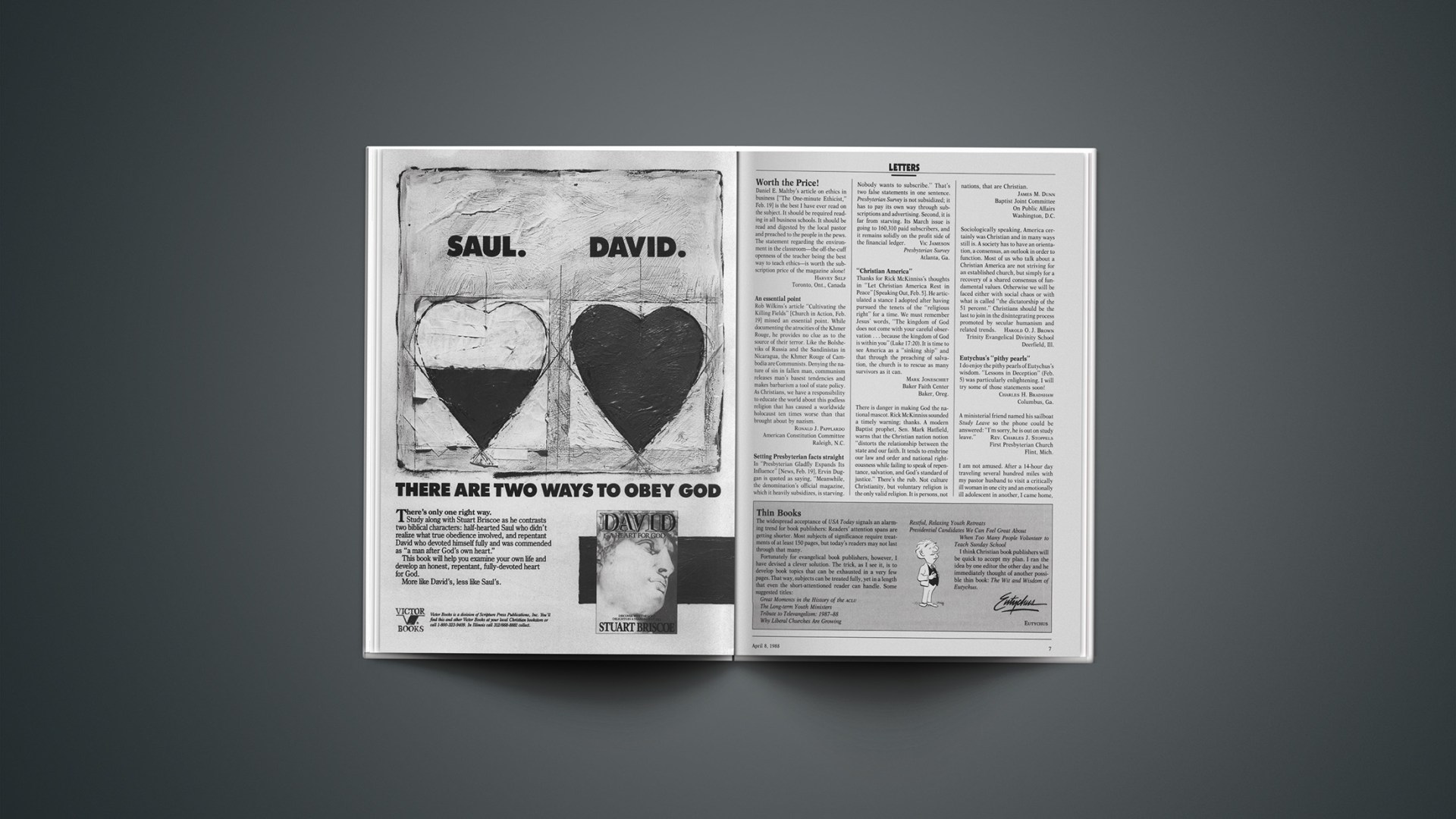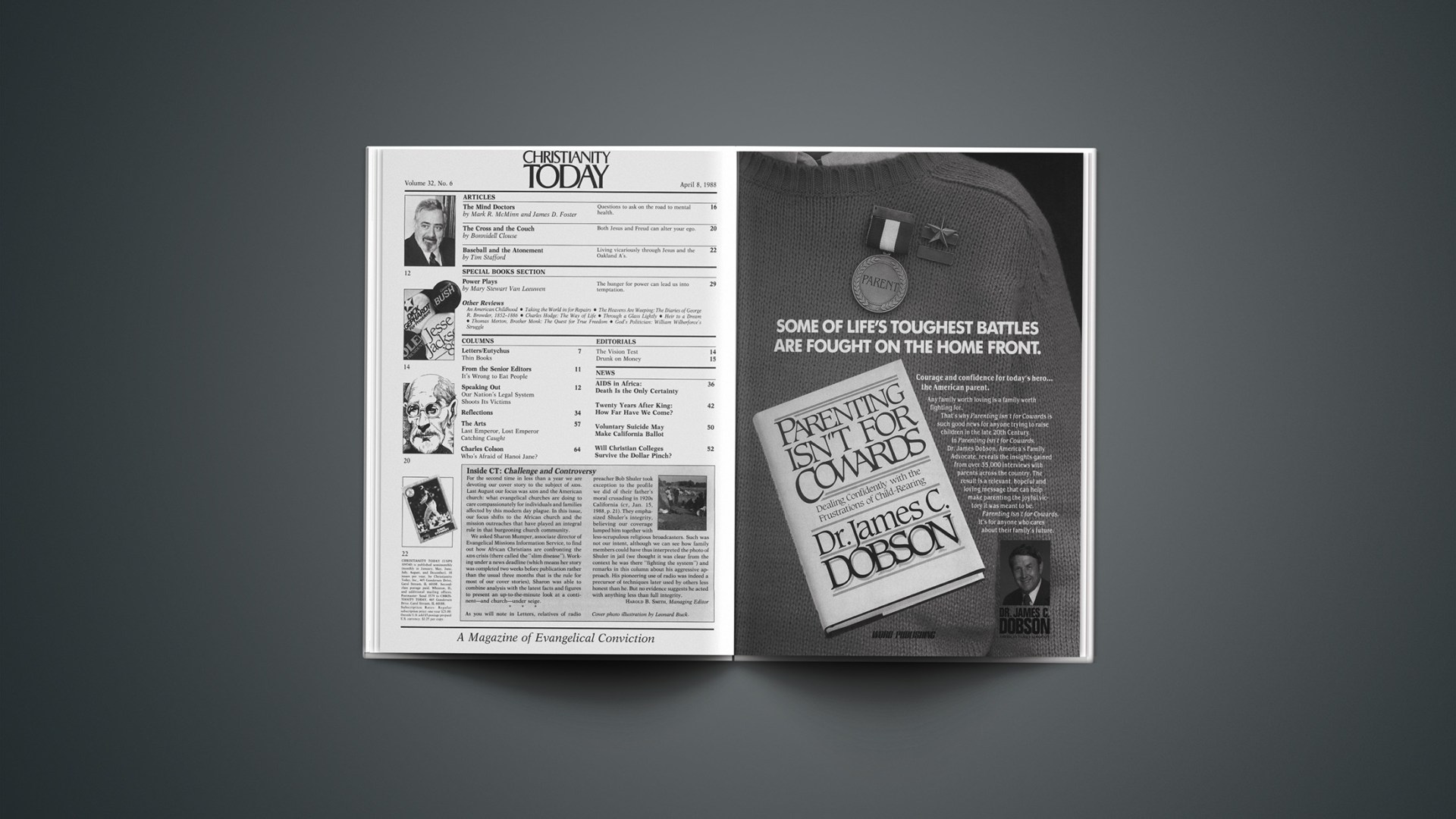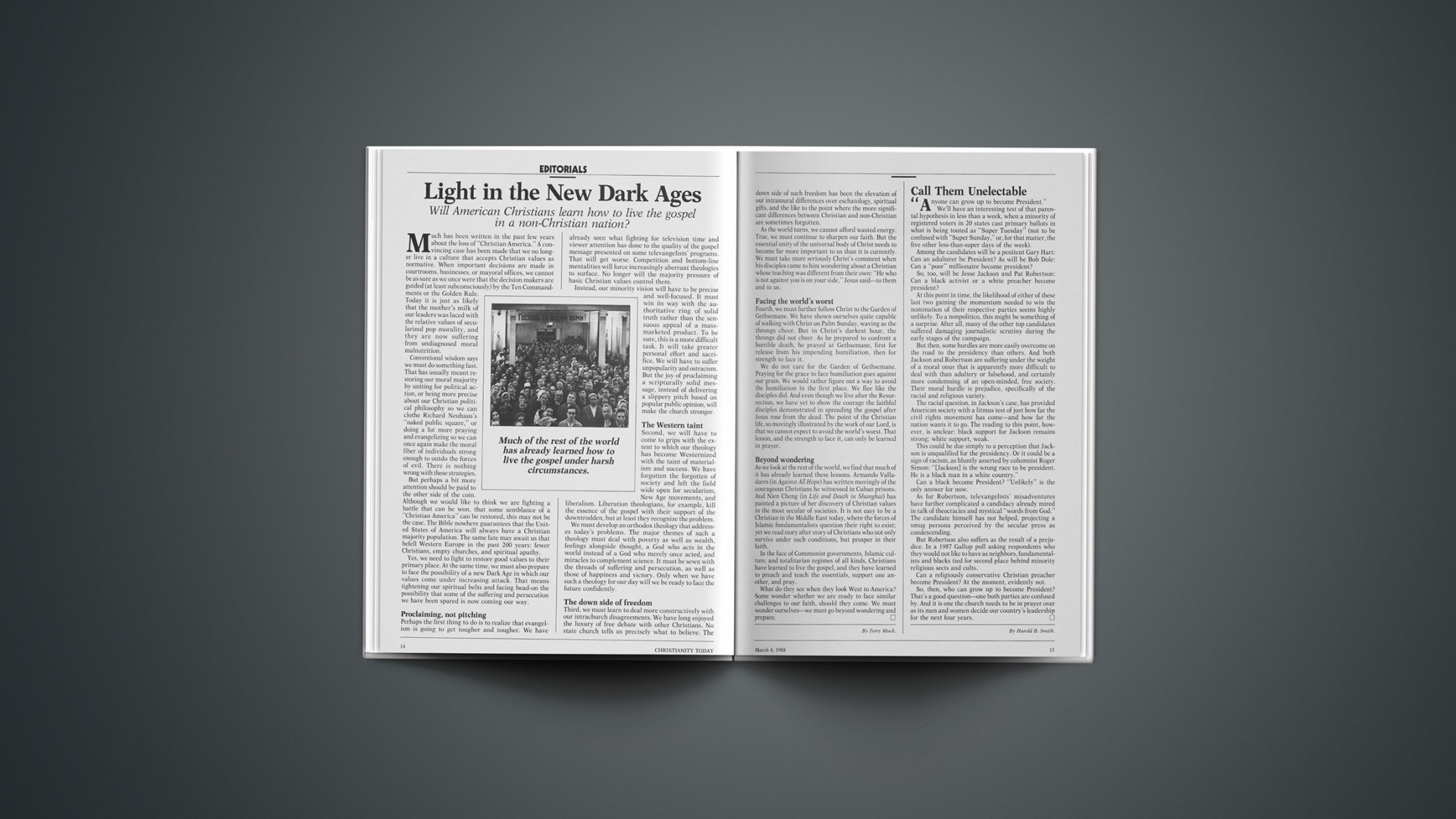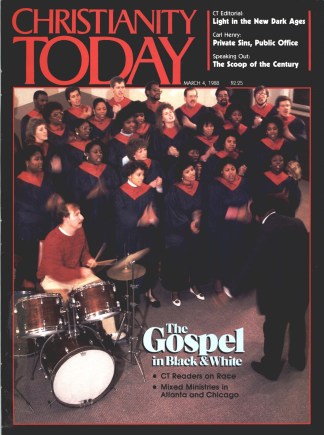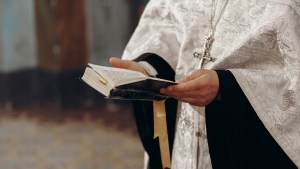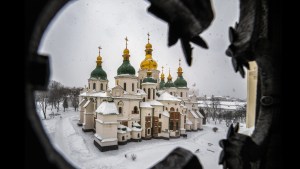Worth the Price!
Daniel E. Maltby’s article on ethics in business [“The One-minute Ethicist,” Feb. 19] is the best I have ever read on the subject. It should be required reading in all business schools. It should be read and digested by the local pastor and preached to the people in the pews. The statement regarding the environment in the classroom—the off-the-cuff openness of the teacher being the best way to teach ethics—is worth the subscription price of the magazine alone!
HARVEY SELF
Toronto, Ont., Canada
An essential point
Rob Wilkins’s article “Cultivating the Killing Fields” [Church in Action, Feb. 19] missed an essential point. While documenting the atrocities of the Khmer Rouge, he provides no clue as to the source of their terror. Like the Bolsheviks of Russia and the Sandinistas in Nicaragua, the Khmer Rouge of Cambodia are Communists. Denying the nature of sin in fallen man, communism releases man’s basest tendencies and makes barbarism a tool of state policy. As Christians, we have a responsibility to educate the world about this godless religion that has caused a worldwide holocaust ten times worse than that brought about by nazism.
RONALD J. PAPPLARDO
American Constitution Committee
Raleigh, N.C.
Setting Presbyterian facts straight
In “Presbyterian Gladfly Expands Its Influence” [News, Feb. 19], Ervin Duggan is quoted as saying, “Meanwhile, the denomination’s official magazine, which it heavily subsidizes, is starving. Nobody wants to subscribe.” That’s two false statements in one sentence. Presbyterian Survey is not subsidized; it has to pay its own way through subscriptions and advertising. Second, it is far from starving. Its March issue is going to 160,310 paid subscribers, and it remains solidly on the profit side of the financial ledger.
VICJAMESON
Presbyterian Survey
Atlanta, Ga.
“Christian America”
Thanks for Rick McKinniss’s thoughts in “Let Christian America Rest in Peace” [Speaking Out, Feb. 5]. He articulated a stance I adopted after having pursued the tenets of the “religious right” for a time. We must remember Jesus’ words, “The kingdom of God does not come with your careful observation … because the kingdom of God is within you” (Luke 17:20). It is time to see America as a “sinking ship” and that through the preaching of salvation, the church is to rescue as many survivors as it can.
MARK JONESCHIET
Baker Faith Center
Baker, Oreg.
There is danger in making God the national mascot. Rick McKinniss sounded a timely warning; thanks. A modern Baptist prophet, Sen. Mark Hatfield, warns that the Christian nation notion “distorts the relationship between the state and our faith. It tends to enshrine our law and order and national righteousness while failing to speak of repentance, salvation, and God’s standard of justice.” There’s the rub. Not culture Christianity, but voluntary religion is the only valid religion. It is persons, notnations, that are Christian.
JAMES M. DUNN
Baptist Joint Committee
On Public Affairs
Washington, D.C.
Sociologically speaking, America certainly was Christian and in many ways still is. A society has to have an orientation, a consensus, an outlook in order to function. Most of us who talk about a Christian America are not striving for an established church, but simply for a recovery of a shared consensus of fundamental values. Otherwise we will be faced either with social chaos or with what is called “the dictatorship of the 51 percent.” Christians should be the last to join in the disintegrating process promoted by secular humanism and related trends.
HAROLD O. J. BROWN
Trinity Evangelical Divinity School
Deerfield, Ill.
Eutychus’s “pithy pearls”
I do enjoy the pithy pearls of Eutychus’s wisdom. “Lessons in Deception” (Feb. 5) was particularly enlightening. I will try some of those statements soon!
CHARLES H. BRADSHAW
Columbus, Ga.
A ministerial friend named his sailboat Study Leave so the phone could be answered: “I’m sorry, he is out on study leave.”
REV. CHARLES J. STOPPELS
First Presbyterian Church
Flint, Mich.
I am not amused. After a 14-hour day traveling several hundred miles with my pastor husband to visit a critically ill woman in one city and an emotionally ill adolescent in another, I came home, put up my weary feet, and picked up CT to read and relax a bit. Unfortunately, the first thing I read was “Eutychus”; I am definitely not relaxed. Since I am the church secretary, I know that for my husband, “out of town” means visiting a hospital, attending a seminar, or taking care of other ministry-related activity. I wish it meant “at home” a lot more often, but it does not.
AMELIA MCKENZIE
New London, Ohio
Thin Books
The widespread acceptance of USA Today signals an alarming trend for book publishers: Readers’ attention spans are getting shorter. Most subjects of significance require treatments of at least 150 pages, but today’s readers may not last through that many.
Fortunately for evangelical book publishers, however, I have devised a clever solution. The trick, as I see it, is to develop book topics that can be exhausted in a very few pages. That way, subjects can be treated fully, yet in a length that even the short-attentioned reader can handle. Some suggested titles:
Great Moments in the History of the ACLU
The Long-term Youth Ministers
Tribute to Televangelism: 1987–88
Why Liberal Churches Are Growing
Restful, Relaxing Youth Retreats
Presidential Candidates We Can Feel Great About
When Too Many People Volunteer to Teach Sunday School
I think Christian book publishers will be quick to accept my plan. I ran the idea by one editor the other day and he immediately thought of another possible thin book: The Wit and Wisdom of Eutychus.
EUTYCHUS
Setting prisoners free
I was disturbed by the political implications of Philip Yancey’s otherwise moving piece on the power of the gospel to set the prisoner free [“Holy Subversion,” Feb. 5], In August 1987 I spent ten days visiting prisons in Chile with a missionary who has worked for years in that system. To compare those prisons with the gulag is a staggering distortion. Yancey painted with a broad stroke and left inaccurate impressions. Young terrorists are in prison for what they have done—not for what they believe.
MARY ANN BELL
McLean Presbyterian Church
McLean, Va.
The sacred text
The Christianity Today Institute is to be congratulated on its fine treatment of the biblical Canon and the true ecumenical style in which it was presented [Feb. 5]. It is a testimony of how God’s revelation, embodied in the Holy Scripture, can be treated with the critical faculties of the human mind and the best of modern scholarship without diminishing the orthodoxy of the doctrine incarnated in the inspired text. The irenic tone of Dr. Kantzer’s closing comments commend themselves to many discussions among Christians which often end on a much less confident and cordial note. This attention to authority, history, and the centrality of biblical revelation should encourage evangelical scholars to confidently engage in dialogue with Orthodox, Catholic, and other Protestant fellow Christians, whose similar seriousness about the sacred text, and the sacred tradition of Jesus Christ embodied therein, have produced such salutary results in the ecumenical movement.
JEFFREY GROS
National Council of the Churches of Christ
New York, N.Y.
Flaming torch—or stake?
As an alumnus of Dallas Seminary, I was dismayed—although not surprised—by the report of three well-respected professors being dismissed on doctrinal grounds [Feb. 5], This institution’s steadfast refusal to countenance a modicum of dissent, even on issues of peripheral importance, is fundamentally incompatible with the spirit of reverent, critical inquiry essential to genuine theological education. Given the degree of tolerance displayed, one might well begin to wonder whether the seminary’s familiar logo depicts a flaming torch or a burning stake.
WILLIAM J. MCCONNELL
Drew University
Madison, N.J.
With regard to CT’S report on the three teachers who left Dallas Seminary’s faculty over the issue of spiritual gifts, I submit the following addendum. Dallas Seminary is not antagonistic toward other evangelical groups or individuals who do not hold our doctrinal standards. Further, we affirm that the supernatural work of God and the power of the Holy Spirit have been manifested throughout the ages and are still evident in this present age.
DONALD K. CAMPBELL, PRESIDENT
Dallas Theological Seminary
Dallas, Tex.
Unification Church doctrine
I was dismayed by your recent article “Unification Church Ties Haunt New Coalition” and the sidebar “Moon’s Theology and Politics” [Feb. 5]. I would like to clarify the attributions made to “Master Speaks.” These speeches were transcribed from partial handwritten notes, which in turn were taken from translators who had little working knowledge of the English language. Not surprisingly, trained Korean translators found these transcripts to be extremely inaccurate. Thus, the quotes you attributed to Rev. Moon are so far removed from the original speaker as to be unworthy of serious consideration.
JOHN BIEMANS
The Unification Church
New York, N.Y.
How dedicated is “dedicated”?
The statement was made in World Scene [Feb. 5] that the Amity Printing Press “is the first printing press in China wholly dedicated to publishing the Scripture.” Not even the propaganda of the TSP M or the press releases of the United Bible Society have dared to say “wholly dedicated.” In fact, Amity Press is capable of printing 3 million volumes per year, but is commited to printing only 250,000 Bibles. This is hardly “wholly dedicated.”
DAVID STRAVERS
World Home Bible League
South Holland, Ill.
In defense of “Fighting Bob”
In “Giving Them Gospel” [Jan. 15], you presented an incomplete and misleading image of my grandfather, Robert P. “Fighting Bob” Shuler. Since I spent much of my youth in his company, I must reply. Dr. Shuler felt it was the duty of a servant of God to fight sin, wherever he felt its presence, with whatever means were at his disposal. In doing so, he indeed “wrought havoc,” as you put it, and was definitely controversial. Here is what you did not say: He pastored a church mightily used by our Lord for over three decades. Countless people came to know the Lord under his ministry. Two of his sons became evangelists.
JACK E. SHULER, D.D.S.
Londonderry, N.H.
My father did not use the gospel or the airwaves to make money for himself. He was on salary. To have him spoken of as the “other Bob Shuler” is ludicrous. He was uniquely himself: God’s man.
NELLA (SHULER) FARTIG
Glendora, Calif.
Bob Shuler, Sr., was colorful and courageous, yes. But he was also Wesleyan and biblical in his Christian witness.
REV. BOB SHULER III
First United Methodist Church
Riverside, Calif.
I have never read a more dishonest description of my father’s 70-year ministry. Your readers will remember the statements of error far longer than those spoken in truth. In referring to my father, John R. Rice stated to me that he had never met a man who was more honest in his dealings with those he criticized!
DR. PHIL SHULER
Phil Shuler Crusades, Inc.
West Hills, Calif.
Our report on Bob Shuler did not take enough account of his pure motives and Christian dedication. We appreciate his family members calling this to our attention.
—Eds.

